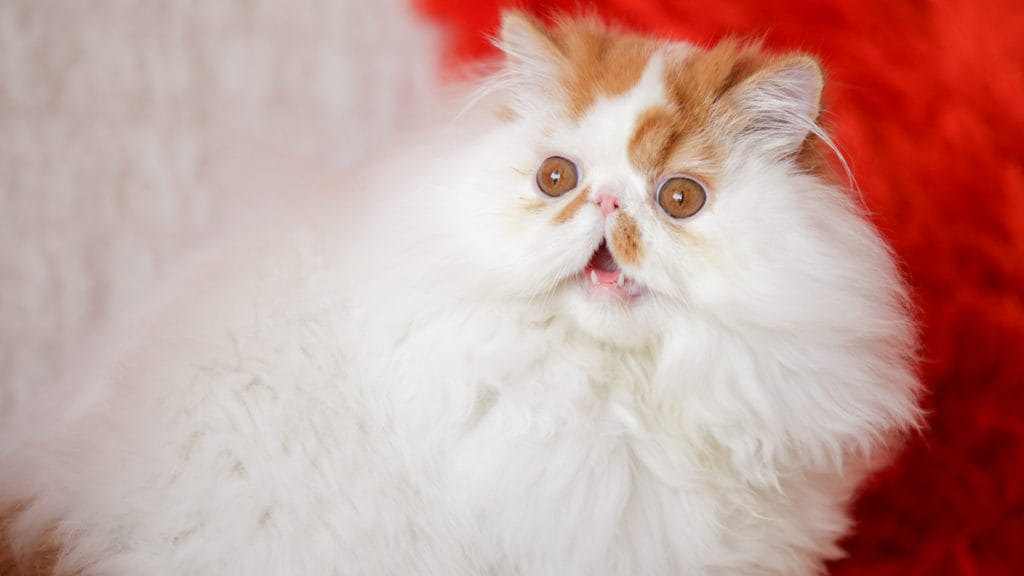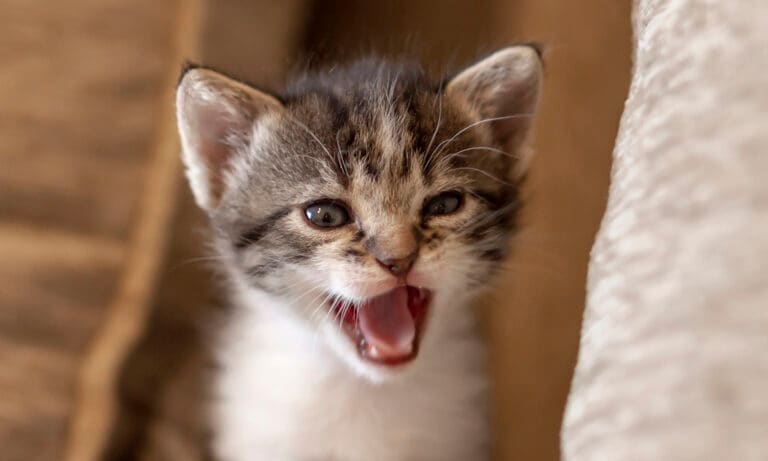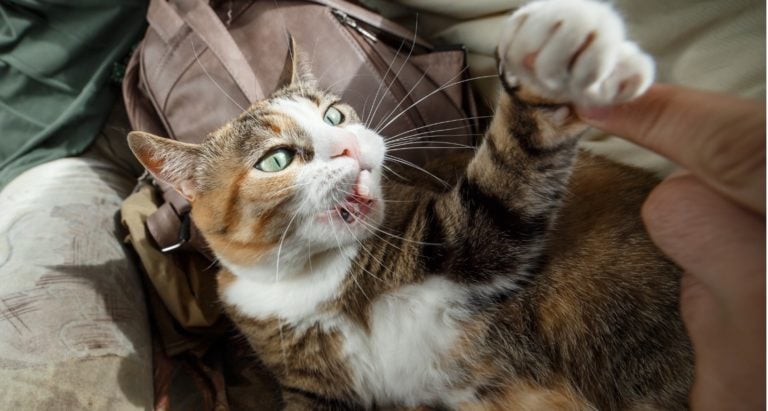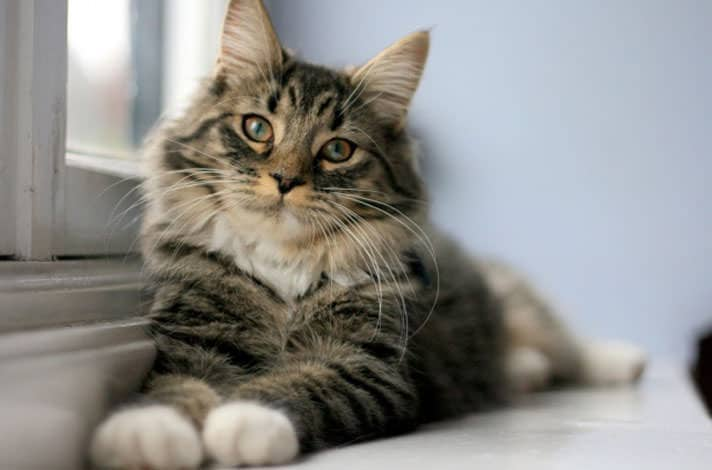Ah, the almighty cucumber—friend to dieters, spa goers and pickle fans, but potential foe to the feline nation. They’ve shown up at farmers markets, in healthy salads and as falafel garnishes, but more recently, they’ve been used as props in YouTube videos starring an unsuspecting feline. If you’ve seen one of these clips, you’re familiar with the encounter between cats and cucumbers—the seemingly harmless green gourd facing off against a seriously scared cat.
These videos have everyone asking, “Why are cats afraid of cucumbers?” And what is the cat behavior instinct that’s behind the sudden change from calm kitty to scared cat? Irith Bloom, Certified Dog Behavior Consultant, CPDT-KSA, VSPDT, KPA CTP, CBATI, VSDTA faculty and Director of Training at The Sophisticated Dog in West Los Angeles, CA, gives us the facts about cats and cucumbers.
Is it really the cucumber that’s scary? Are cats and cucumbers natural enemies in an alternate universe? Obviously not, and Bloom affirms that there’s no reason to believe cats are afraid of cucumbers in particular. A cucumber isn’t something that’s normally on the floor, though, and it may be a new smell that they haven’t encountered before. “Being suspicious of new things is a good way to stay safe,” remarks Bloom. And although it’s possible that the long, narrow shape and green color remind a cat of a snake, “It’s much more likely that a cat would be startled by just about anything ‘out of place’ that gets put behind the cat while the cat is not looking,” says Bloom.
Why do they react the way they do? To answer this question, we need to know a little about cat behavior. If you’re a cat, you are potential prey for predators like dogs or coyotes, explains Bloom. Survival means being aware of your surroundings at all times. “When something appears suddenly, reacting in a startled way helps the cat avoid getting killed or injured,” Bloom notes. She points out that humans aren’t so different. We’ve all jumped at the sight of something unexpected lurking in our peripheral vision, or when someone sneaks up suddenly behind us. So, it’s really not weird that when cats and cucumbers come face to face, you end up with a scared cat that jumps a few feet into the air.
How kitties use their senses: Being prey animals, cats will test out and explore new things in their environment through their sense of smell. “Since cats don’t see as well close-up as humans do,” says Bloom, “they will generally sniff new things to learn more about them.” They will approach the intrusive object cautiously to assess whether it’s safe. “These cats need to make sure the unfamiliar thing is not going to hurt them in any way, and approaching slowly is a good way to find out more before putting themselves at risk.” Bloom advises letting a cat go up to any new household addition on their own rather than putting an object right in front of the cat, which inevitably leads to a scared cat. And this brings us to our main point about the whole cats and cucumbers debacle.
A “joke” that’s not so funny: You might have innocently thought that putting a cucumber behind an unsuspecting cat, or watching a video that shows it, is pretty harmless. But Bloom is very clear about the repercussions of this seemingly innocuous “joke.” She states that “’Pranking’ cats this way clearly causes them stress, and that stress—and the resulting emotional trauma—could potentially last a long time. Imagine how you would feel if things kept sneaking up on you when you were turned the other way, or enjoying a good meal, or sleeping. You might start checking your environment over and over to avoid being snuck up on, or find it hard to relax while you eat, or sleep more poorly. You might also decide that the world is simply not safe.” Bloom points out that instead of just a scared cat, you will end up with a cat that is extremely insecure about their surroundings. Your kitty could become terrified of the room where the encounter took place, or she could associate being startled with a person that was nearby or a certain sound that was made at the same time she saw the green monster. Even worse, people tend to play this prank after the cat has eaten, which Bloom says can make the cat scared of a certain food, scared to eat in general, or scared to go near the food dish—some serious problems. Cats with sensitive systems might even vomit from stress or choke. “In other words, these kinds of pranks are bad for your cat’s physical and mental/emotional health,” says Bloom. The point is, don’t be that cat owner. For your cat’s sake, just don’t play the cats and cucumbers prank, and be an advocate against it when you have the opportunity.
Be part of the solution to kitty stress: Now sometimes you’ll have a feline that’s just naturally anxious, or one that turns into a pretty scared cat when there are changes in her environment that you can’t help. For situations like loud fireworks or vet visits, try a calming ThunderShirt or Sentry’s Calming Collar with soothing pheromones. When it’s time to go to the vet or travel, a spritz of Nature’s Miracle Calming Spray inside the cat carrier will help decrease the stress. Treat-driven cats can be comforted with delicious, chicken-flavored VetriScience Composure chews.
So, we’ve learned enough about cat behavior to know that cucumbers are not a cat’s natural arch-enemy, and why this prank is dangerous and not worth the few seconds of online fame. Instead of creating a perpetually scared cat, just say no to help your kitty stay as cool as a cucumber.

Nikki Naser, BeChewy Senior Editor
Instead of owning 30 cats, Nikki has an impressive collection of 30 cat-themed T-shirts, and just 4 pets—a ginger-haired senior cat, a senior Maine Coon, a middle-aged Choodle, and a young kitty who showed up one day on the back steps. A former Orlando resident, Nikki worked on several tourism publications before moving to South Beach. When she’s not stopping to take pics of community cats to post on Instagram, Nikki spends her time with the office pets at Chewy, writing for their BeChewy blog.
Share:













